Analysis of People Management Practices within the NHS Context
VerifiedAdded on 2023/01/11
|9
|2373
|94
Report
AI Summary
This report provides an overview of people management within the National Health Service (NHS) in England, examining key theoretical models, roles, priorities, and influences affecting leadership, training, development, and talent management. It begins by introducing the concept of people management and its importance in achieving organizational goals, highlighting the role of the HR department in various functions such as training, hiring, and employee welfare. The report then delves into specific leadership theories like contingency theory and transition models, explaining their application within the NHS context. It also discusses the expectancy theory in relation to talent management and employee motivation. Furthermore, the report analyzes the roles and priorities of NHS management, emphasizing the importance of training, employee relations, and effective recruitment. It also explores internal and external factors impacting leadership, training, and talent management within the NHS. Finally, the report concludes with recommendations for improving people management practices within the NHS, focusing on creating a positive work environment, providing effective training, and fostering strong leadership.
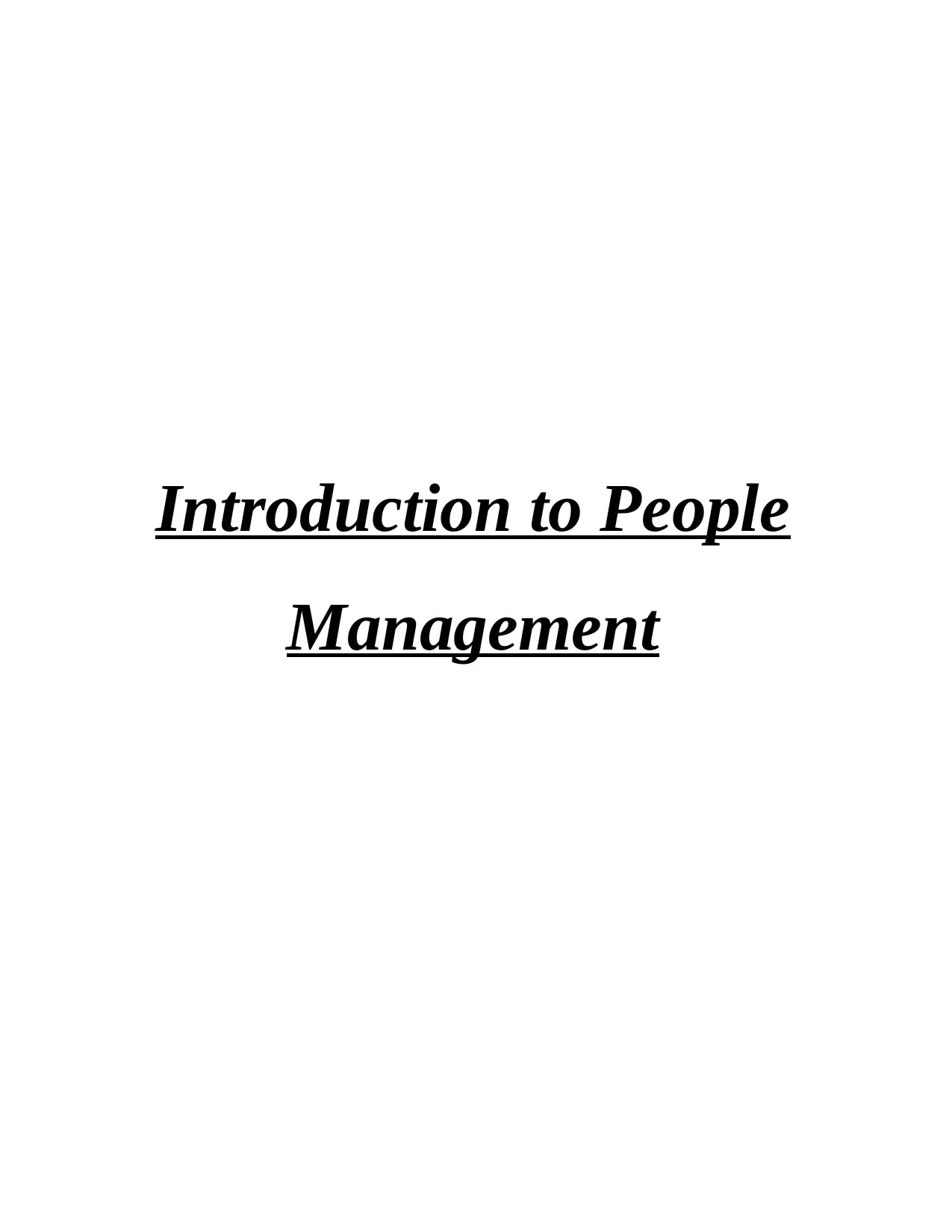
Introduction to People
Management
Management
Paraphrase This Document
Need a fresh take? Get an instant paraphrase of this document with our AI Paraphraser
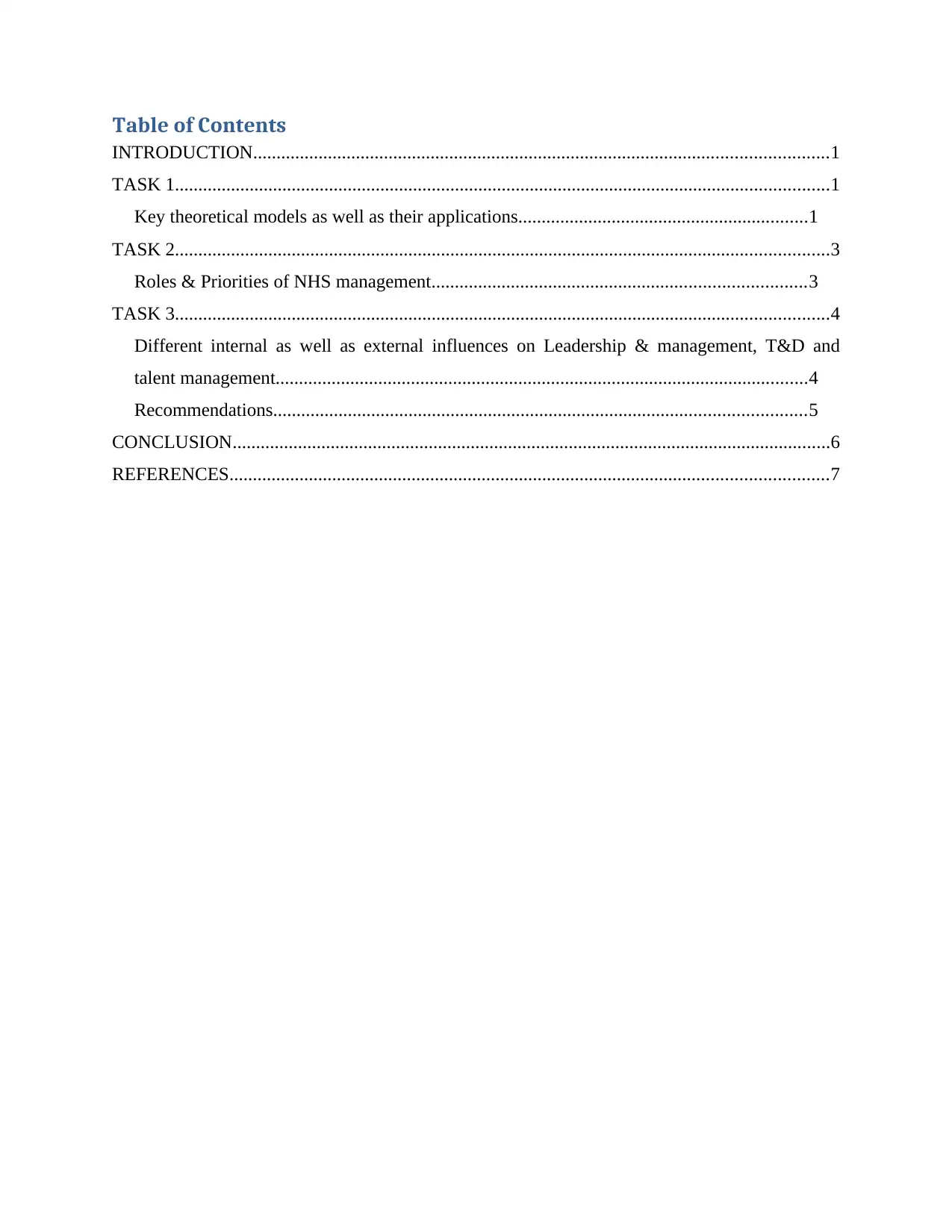
Table of Contents
INTRODUCTION...........................................................................................................................1
TASK 1............................................................................................................................................1
Key theoretical models as well as their applications..............................................................1
TASK 2............................................................................................................................................3
Roles & Priorities of NHS management................................................................................3
TASK 3............................................................................................................................................4
Different internal as well as external influences on Leadership & management, T&D and
talent management..................................................................................................................4
Recommendations..................................................................................................................5
CONCLUSION................................................................................................................................6
REFERENCES................................................................................................................................7
INTRODUCTION...........................................................................................................................1
TASK 1............................................................................................................................................1
Key theoretical models as well as their applications..............................................................1
TASK 2............................................................................................................................................3
Roles & Priorities of NHS management................................................................................3
TASK 3............................................................................................................................................4
Different internal as well as external influences on Leadership & management, T&D and
talent management..................................................................................................................4
Recommendations..................................................................................................................5
CONCLUSION................................................................................................................................6
REFERENCES................................................................................................................................7
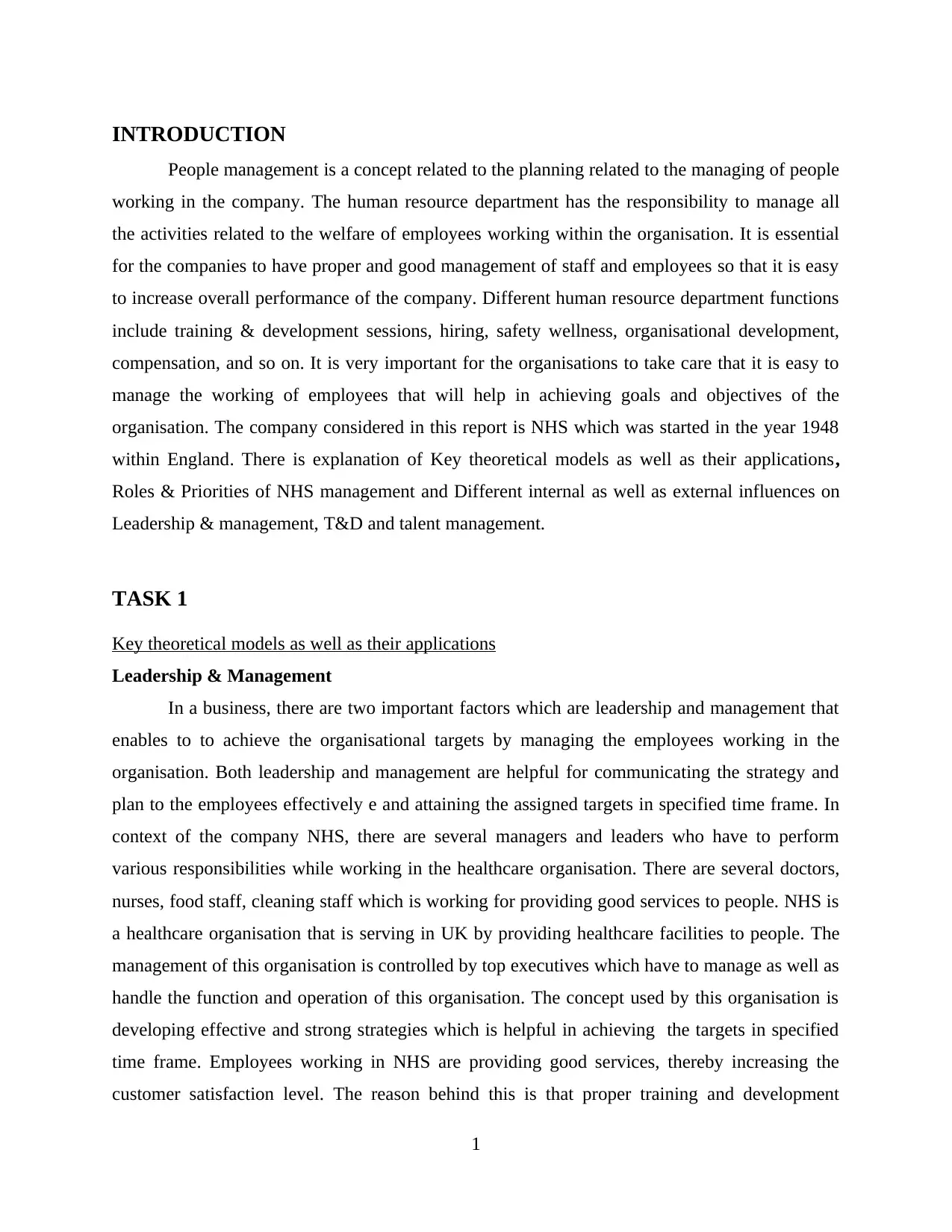
INTRODUCTION
People management is a concept related to the planning related to the managing of people
working in the company. The human resource department has the responsibility to manage all
the activities related to the welfare of employees working within the organisation. It is essential
for the companies to have proper and good management of staff and employees so that it is easy
to increase overall performance of the company. Different human resource department functions
include training & development sessions, hiring, safety wellness, organisational development,
compensation, and so on. It is very important for the organisations to take care that it is easy to
manage the working of employees that will help in achieving goals and objectives of the
organisation. The company considered in this report is NHS which was started in the year 1948
within England. There is explanation of Key theoretical models as well as their applications,
Roles & Priorities of NHS management and Different internal as well as external influences on
Leadership & management, T&D and talent management.
TASK 1
Key theoretical models as well as their applications
Leadership & Management
In a business, there are two important factors which are leadership and management that
enables to to achieve the organisational targets by managing the employees working in the
organisation. Both leadership and management are helpful for communicating the strategy and
plan to the employees effectively e and attaining the assigned targets in specified time frame. In
context of the company NHS, there are several managers and leaders who have to perform
various responsibilities while working in the healthcare organisation. There are several doctors,
nurses, food staff, cleaning staff which is working for providing good services to people. NHS is
a healthcare organisation that is serving in UK by providing healthcare facilities to people. The
management of this organisation is controlled by top executives which have to manage as well as
handle the function and operation of this organisation. The concept used by this organisation is
developing effective and strong strategies which is helpful in achieving the targets in specified
time frame. Employees working in NHS are providing good services, thereby increasing the
customer satisfaction level. The reason behind this is that proper training and development
1
People management is a concept related to the planning related to the managing of people
working in the company. The human resource department has the responsibility to manage all
the activities related to the welfare of employees working within the organisation. It is essential
for the companies to have proper and good management of staff and employees so that it is easy
to increase overall performance of the company. Different human resource department functions
include training & development sessions, hiring, safety wellness, organisational development,
compensation, and so on. It is very important for the organisations to take care that it is easy to
manage the working of employees that will help in achieving goals and objectives of the
organisation. The company considered in this report is NHS which was started in the year 1948
within England. There is explanation of Key theoretical models as well as their applications,
Roles & Priorities of NHS management and Different internal as well as external influences on
Leadership & management, T&D and talent management.
TASK 1
Key theoretical models as well as their applications
Leadership & Management
In a business, there are two important factors which are leadership and management that
enables to to achieve the organisational targets by managing the employees working in the
organisation. Both leadership and management are helpful for communicating the strategy and
plan to the employees effectively e and attaining the assigned targets in specified time frame. In
context of the company NHS, there are several managers and leaders who have to perform
various responsibilities while working in the healthcare organisation. There are several doctors,
nurses, food staff, cleaning staff which is working for providing good services to people. NHS is
a healthcare organisation that is serving in UK by providing healthcare facilities to people. The
management of this organisation is controlled by top executives which have to manage as well as
handle the function and operation of this organisation. The concept used by this organisation is
developing effective and strong strategies which is helpful in achieving the targets in specified
time frame. Employees working in NHS are providing good services, thereby increasing the
customer satisfaction level. The reason behind this is that proper training and development
1
⊘ This is a preview!⊘
Do you want full access?
Subscribe today to unlock all pages.

Trusted by 1+ million students worldwide
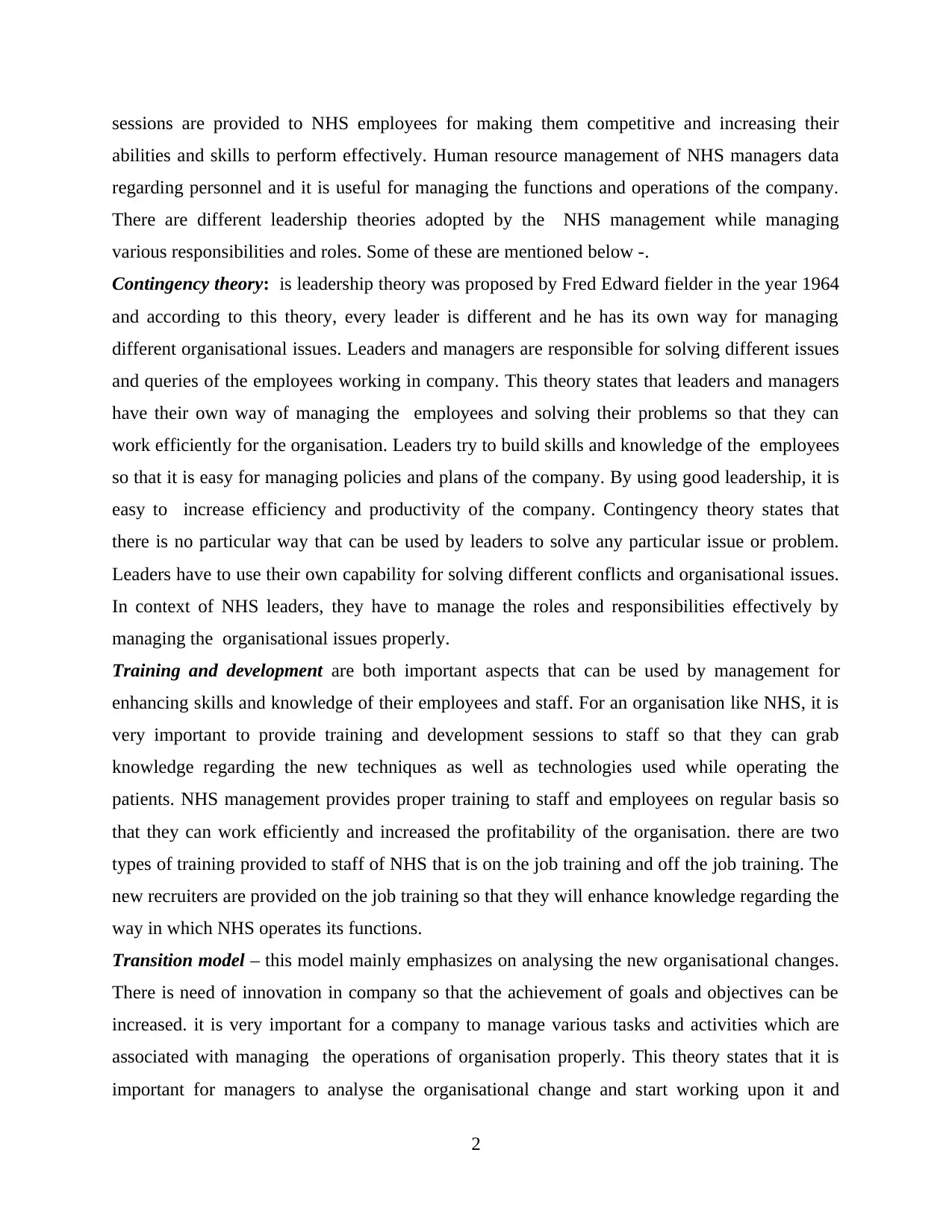
sessions are provided to NHS employees for making them competitive and increasing their
abilities and skills to perform effectively. Human resource management of NHS managers data
regarding personnel and it is useful for managing the functions and operations of the company.
There are different leadership theories adopted by the NHS management while managing
various responsibilities and roles. Some of these are mentioned below -.
Contingency theory: is leadership theory was proposed by Fred Edward fielder in the year 1964
and according to this theory, every leader is different and he has its own way for managing
different organisational issues. Leaders and managers are responsible for solving different issues
and queries of the employees working in company. This theory states that leaders and managers
have their own way of managing the employees and solving their problems so that they can
work efficiently for the organisation. Leaders try to build skills and knowledge of the employees
so that it is easy for managing policies and plans of the company. By using good leadership, it is
easy to increase efficiency and productivity of the company. Contingency theory states that
there is no particular way that can be used by leaders to solve any particular issue or problem.
Leaders have to use their own capability for solving different conflicts and organisational issues.
In context of NHS leaders, they have to manage the roles and responsibilities effectively by
managing the organisational issues properly.
Training and development are both important aspects that can be used by management for
enhancing skills and knowledge of their employees and staff. For an organisation like NHS, it is
very important to provide training and development sessions to staff so that they can grab
knowledge regarding the new techniques as well as technologies used while operating the
patients. NHS management provides proper training to staff and employees on regular basis so
that they can work efficiently and increased the profitability of the organisation. there are two
types of training provided to staff of NHS that is on the job training and off the job training. The
new recruiters are provided on the job training so that they will enhance knowledge regarding the
way in which NHS operates its functions.
Transition model – this model mainly emphasizes on analysing the new organisational changes.
There is need of innovation in company so that the achievement of goals and objectives can be
increased. it is very important for a company to manage various tasks and activities which are
associated with managing the operations of organisation properly. This theory states that it is
important for managers to analyse the organisational change and start working upon it and
2
abilities and skills to perform effectively. Human resource management of NHS managers data
regarding personnel and it is useful for managing the functions and operations of the company.
There are different leadership theories adopted by the NHS management while managing
various responsibilities and roles. Some of these are mentioned below -.
Contingency theory: is leadership theory was proposed by Fred Edward fielder in the year 1964
and according to this theory, every leader is different and he has its own way for managing
different organisational issues. Leaders and managers are responsible for solving different issues
and queries of the employees working in company. This theory states that leaders and managers
have their own way of managing the employees and solving their problems so that they can
work efficiently for the organisation. Leaders try to build skills and knowledge of the employees
so that it is easy for managing policies and plans of the company. By using good leadership, it is
easy to increase efficiency and productivity of the company. Contingency theory states that
there is no particular way that can be used by leaders to solve any particular issue or problem.
Leaders have to use their own capability for solving different conflicts and organisational issues.
In context of NHS leaders, they have to manage the roles and responsibilities effectively by
managing the organisational issues properly.
Training and development are both important aspects that can be used by management for
enhancing skills and knowledge of their employees and staff. For an organisation like NHS, it is
very important to provide training and development sessions to staff so that they can grab
knowledge regarding the new techniques as well as technologies used while operating the
patients. NHS management provides proper training to staff and employees on regular basis so
that they can work efficiently and increased the profitability of the organisation. there are two
types of training provided to staff of NHS that is on the job training and off the job training. The
new recruiters are provided on the job training so that they will enhance knowledge regarding the
way in which NHS operates its functions.
Transition model – this model mainly emphasizes on analysing the new organisational changes.
There is need of innovation in company so that the achievement of goals and objectives can be
increased. it is very important for a company to manage various tasks and activities which are
associated with managing the operations of organisation properly. This theory states that it is
important for managers to analyse the organisational change and start working upon it and
2
Paraphrase This Document
Need a fresh take? Get an instant paraphrase of this document with our AI Paraphraser
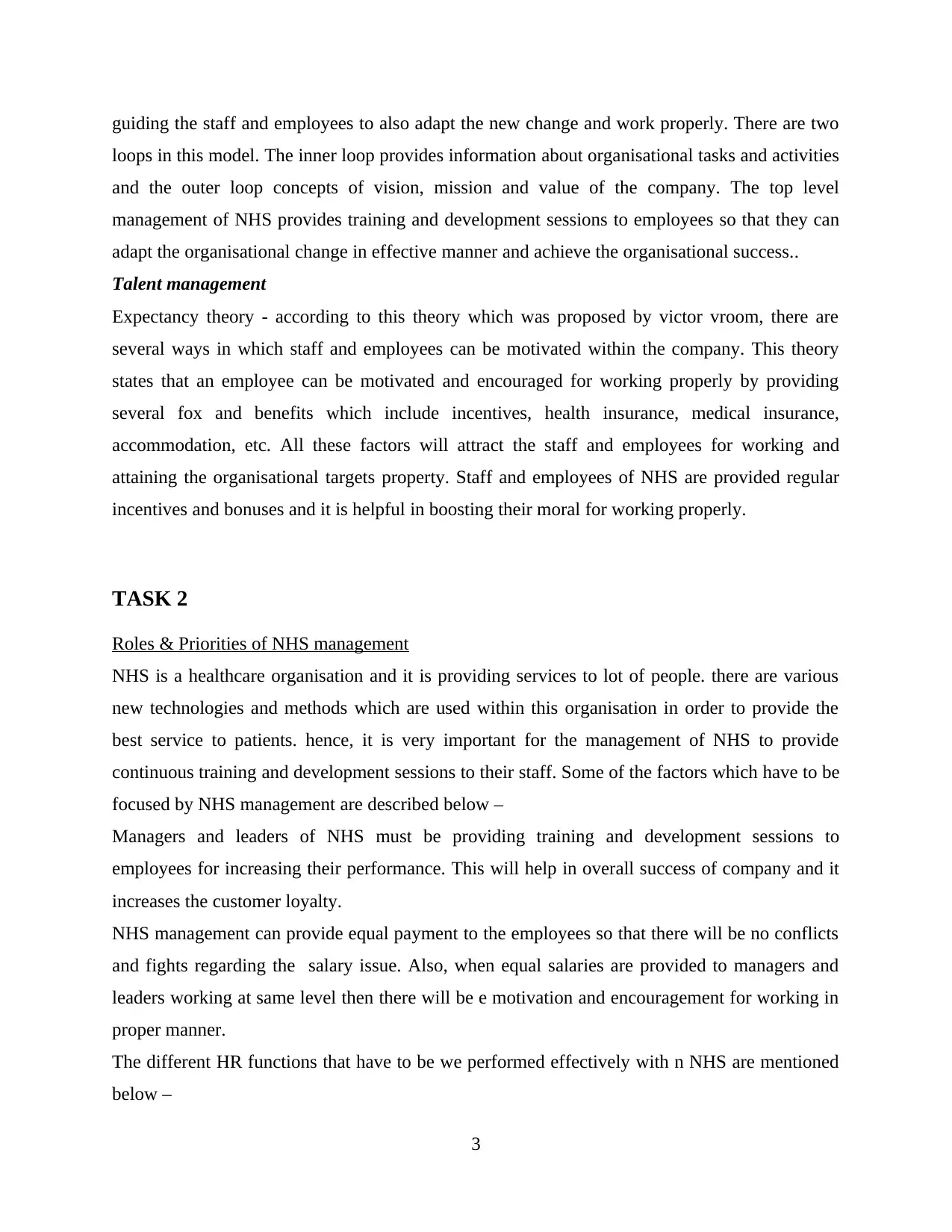
guiding the staff and employees to also adapt the new change and work properly. There are two
loops in this model. The inner loop provides information about organisational tasks and activities
and the outer loop concepts of vision, mission and value of the company. The top level
management of NHS provides training and development sessions to employees so that they can
adapt the organisational change in effective manner and achieve the organisational success..
Talent management
Expectancy theory - according to this theory which was proposed by victor vroom, there are
several ways in which staff and employees can be motivated within the company. This theory
states that an employee can be motivated and encouraged for working properly by providing
several fox and benefits which include incentives, health insurance, medical insurance,
accommodation, etc. All these factors will attract the staff and employees for working and
attaining the organisational targets property. Staff and employees of NHS are provided regular
incentives and bonuses and it is helpful in boosting their moral for working properly.
TASK 2
Roles & Priorities of NHS management
NHS is a healthcare organisation and it is providing services to lot of people. there are various
new technologies and methods which are used within this organisation in order to provide the
best service to patients. hence, it is very important for the management of NHS to provide
continuous training and development sessions to their staff. Some of the factors which have to be
focused by NHS management are described below –
Managers and leaders of NHS must be providing training and development sessions to
employees for increasing their performance. This will help in overall success of company and it
increases the customer loyalty.
NHS management can provide equal payment to the employees so that there will be no conflicts
and fights regarding the salary issue. Also, when equal salaries are provided to managers and
leaders working at same level then there will be e motivation and encouragement for working in
proper manner.
The different HR functions that have to be we performed effectively with n NHS are mentioned
below –
3
loops in this model. The inner loop provides information about organisational tasks and activities
and the outer loop concepts of vision, mission and value of the company. The top level
management of NHS provides training and development sessions to employees so that they can
adapt the organisational change in effective manner and achieve the organisational success..
Talent management
Expectancy theory - according to this theory which was proposed by victor vroom, there are
several ways in which staff and employees can be motivated within the company. This theory
states that an employee can be motivated and encouraged for working properly by providing
several fox and benefits which include incentives, health insurance, medical insurance,
accommodation, etc. All these factors will attract the staff and employees for working and
attaining the organisational targets property. Staff and employees of NHS are provided regular
incentives and bonuses and it is helpful in boosting their moral for working properly.
TASK 2
Roles & Priorities of NHS management
NHS is a healthcare organisation and it is providing services to lot of people. there are various
new technologies and methods which are used within this organisation in order to provide the
best service to patients. hence, it is very important for the management of NHS to provide
continuous training and development sessions to their staff. Some of the factors which have to be
focused by NHS management are described below –
Managers and leaders of NHS must be providing training and development sessions to
employees for increasing their performance. This will help in overall success of company and it
increases the customer loyalty.
NHS management can provide equal payment to the employees so that there will be no conflicts
and fights regarding the salary issue. Also, when equal salaries are provided to managers and
leaders working at same level then there will be e motivation and encouragement for working in
proper manner.
The different HR functions that have to be we performed effectively with n NHS are mentioned
below –
3
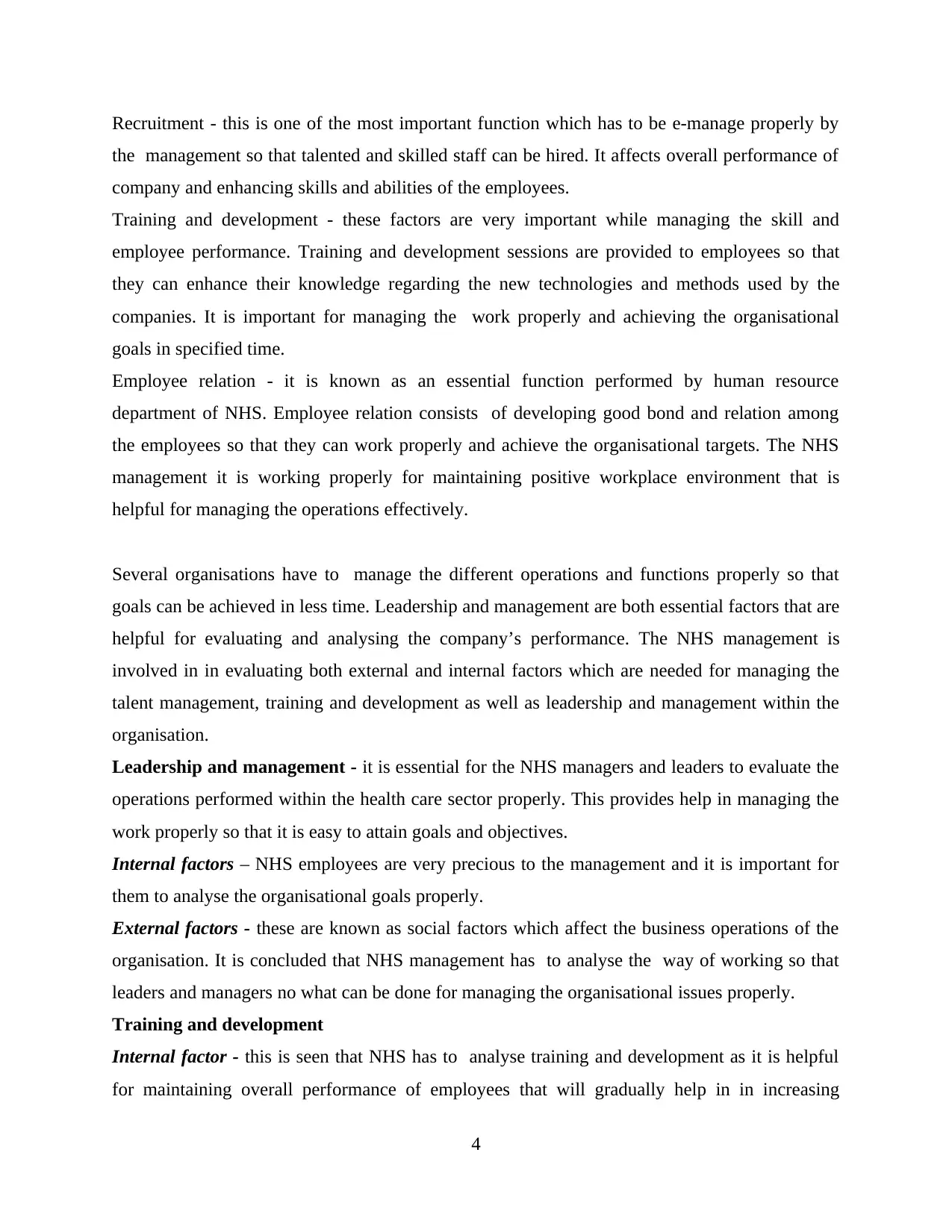
Recruitment - this is one of the most important function which has to be e-manage properly by
the management so that talented and skilled staff can be hired. It affects overall performance of
company and enhancing skills and abilities of the employees.
Training and development - these factors are very important while managing the skill and
employee performance. Training and development sessions are provided to employees so that
they can enhance their knowledge regarding the new technologies and methods used by the
companies. It is important for managing the work properly and achieving the organisational
goals in specified time.
Employee relation - it is known as an essential function performed by human resource
department of NHS. Employee relation consists of developing good bond and relation among
the employees so that they can work properly and achieve the organisational targets. The NHS
management it is working properly for maintaining positive workplace environment that is
helpful for managing the operations effectively.
Several organisations have to manage the different operations and functions properly so that
goals can be achieved in less time. Leadership and management are both essential factors that are
helpful for evaluating and analysing the company’s performance. The NHS management is
involved in in evaluating both external and internal factors which are needed for managing the
talent management, training and development as well as leadership and management within the
organisation.
Leadership and management - it is essential for the NHS managers and leaders to evaluate the
operations performed within the health care sector properly. This provides help in managing the
work properly so that it is easy to attain goals and objectives.
Internal factors – NHS employees are very precious to the management and it is important for
them to analyse the organisational goals properly.
External factors - these are known as social factors which affect the business operations of the
organisation. It is concluded that NHS management has to analyse the way of working so that
leaders and managers no what can be done for managing the organisational issues properly.
Training and development
Internal factor - this is seen that NHS has to analyse training and development as it is helpful
for maintaining overall performance of employees that will gradually help in in increasing
4
the management so that talented and skilled staff can be hired. It affects overall performance of
company and enhancing skills and abilities of the employees.
Training and development - these factors are very important while managing the skill and
employee performance. Training and development sessions are provided to employees so that
they can enhance their knowledge regarding the new technologies and methods used by the
companies. It is important for managing the work properly and achieving the organisational
goals in specified time.
Employee relation - it is known as an essential function performed by human resource
department of NHS. Employee relation consists of developing good bond and relation among
the employees so that they can work properly and achieve the organisational targets. The NHS
management it is working properly for maintaining positive workplace environment that is
helpful for managing the operations effectively.
Several organisations have to manage the different operations and functions properly so that
goals can be achieved in less time. Leadership and management are both essential factors that are
helpful for evaluating and analysing the company’s performance. The NHS management is
involved in in evaluating both external and internal factors which are needed for managing the
talent management, training and development as well as leadership and management within the
organisation.
Leadership and management - it is essential for the NHS managers and leaders to evaluate the
operations performed within the health care sector properly. This provides help in managing the
work properly so that it is easy to attain goals and objectives.
Internal factors – NHS employees are very precious to the management and it is important for
them to analyse the organisational goals properly.
External factors - these are known as social factors which affect the business operations of the
organisation. It is concluded that NHS management has to analyse the way of working so that
leaders and managers no what can be done for managing the organisational issues properly.
Training and development
Internal factor - this is seen that NHS has to analyse training and development as it is helpful
for maintaining overall performance of employees that will gradually help in in increasing
4
⊘ This is a preview!⊘
Do you want full access?
Subscribe today to unlock all pages.

Trusted by 1+ million students worldwide
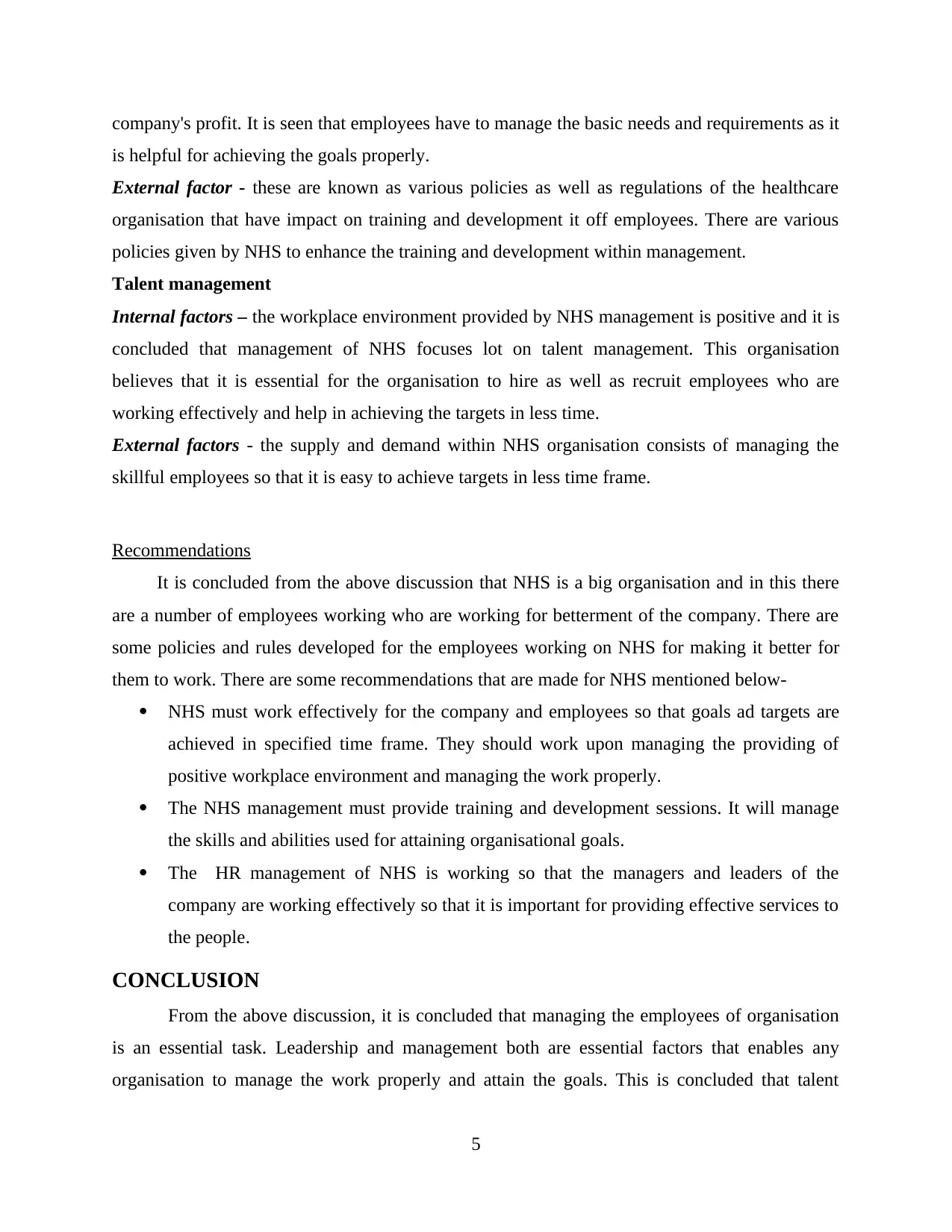
company's profit. It is seen that employees have to manage the basic needs and requirements as it
is helpful for achieving the goals properly.
External factor - these are known as various policies as well as regulations of the healthcare
organisation that have impact on training and development it off employees. There are various
policies given by NHS to enhance the training and development within management.
Talent management
Internal factors – the workplace environment provided by NHS management is positive and it is
concluded that management of NHS focuses lot on talent management. This organisation
believes that it is essential for the organisation to hire as well as recruit employees who are
working effectively and help in achieving the targets in less time.
External factors - the supply and demand within NHS organisation consists of managing the
skillful employees so that it is easy to achieve targets in less time frame.
Recommendations
It is concluded from the above discussion that NHS is a big organisation and in this there
are a number of employees working who are working for betterment of the company. There are
some policies and rules developed for the employees working on NHS for making it better for
them to work. There are some recommendations that are made for NHS mentioned below-
NHS must work effectively for the company and employees so that goals ad targets are
achieved in specified time frame. They should work upon managing the providing of
positive workplace environment and managing the work properly.
The NHS management must provide training and development sessions. It will manage
the skills and abilities used for attaining organisational goals.
The HR management of NHS is working so that the managers and leaders of the
company are working effectively so that it is important for providing effective services to
the people.
CONCLUSION
From the above discussion, it is concluded that managing the employees of organisation
is an essential task. Leadership and management both are essential factors that enables any
organisation to manage the work properly and attain the goals. This is concluded that talent
5
is helpful for achieving the goals properly.
External factor - these are known as various policies as well as regulations of the healthcare
organisation that have impact on training and development it off employees. There are various
policies given by NHS to enhance the training and development within management.
Talent management
Internal factors – the workplace environment provided by NHS management is positive and it is
concluded that management of NHS focuses lot on talent management. This organisation
believes that it is essential for the organisation to hire as well as recruit employees who are
working effectively and help in achieving the targets in less time.
External factors - the supply and demand within NHS organisation consists of managing the
skillful employees so that it is easy to achieve targets in less time frame.
Recommendations
It is concluded from the above discussion that NHS is a big organisation and in this there
are a number of employees working who are working for betterment of the company. There are
some policies and rules developed for the employees working on NHS for making it better for
them to work. There are some recommendations that are made for NHS mentioned below-
NHS must work effectively for the company and employees so that goals ad targets are
achieved in specified time frame. They should work upon managing the providing of
positive workplace environment and managing the work properly.
The NHS management must provide training and development sessions. It will manage
the skills and abilities used for attaining organisational goals.
The HR management of NHS is working so that the managers and leaders of the
company are working effectively so that it is important for providing effective services to
the people.
CONCLUSION
From the above discussion, it is concluded that managing the employees of organisation
is an essential task. Leadership and management both are essential factors that enables any
organisation to manage the work properly and attain the goals. This is concluded that talent
5
Paraphrase This Document
Need a fresh take? Get an instant paraphrase of this document with our AI Paraphraser
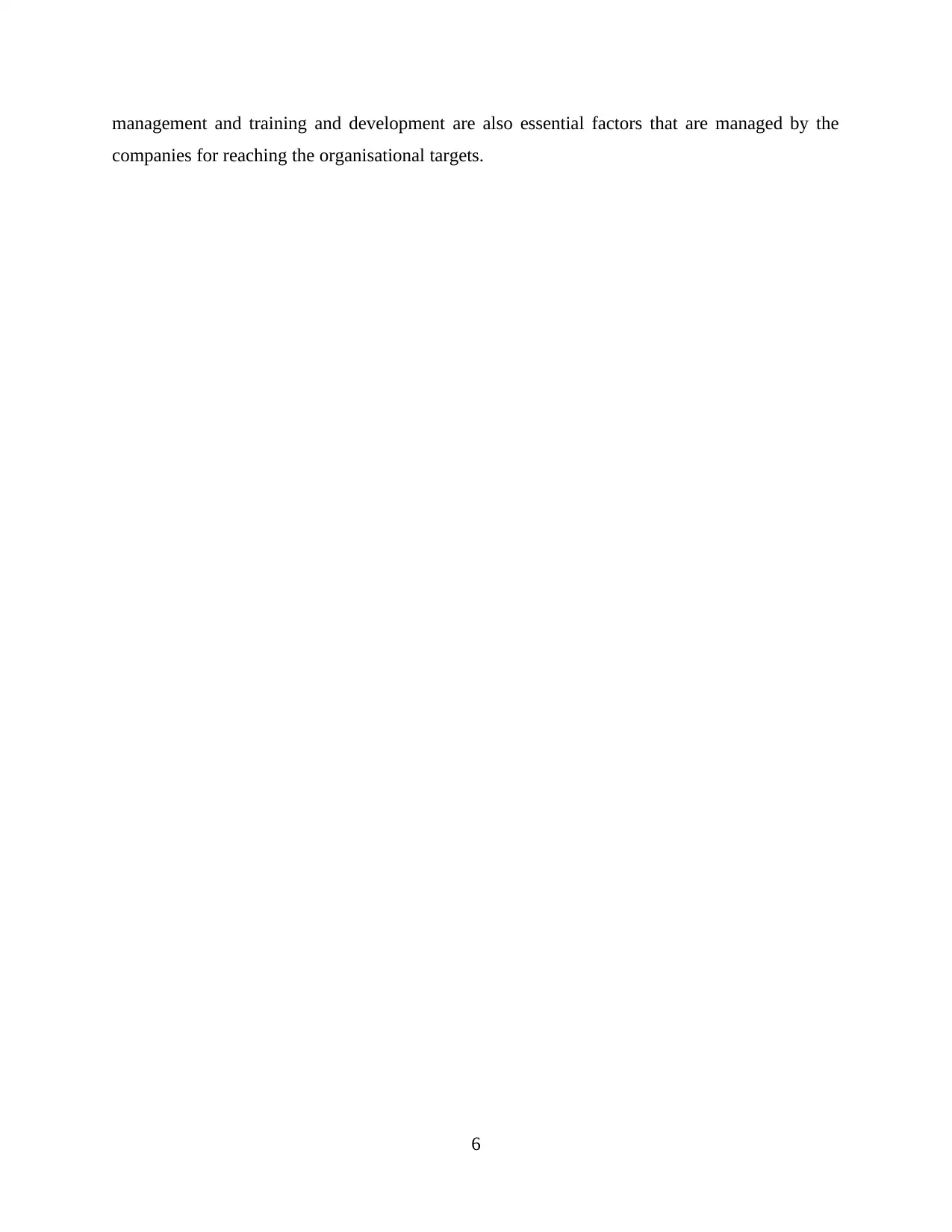
management and training and development are also essential factors that are managed by the
companies for reaching the organisational targets.
6
companies for reaching the organisational targets.
6
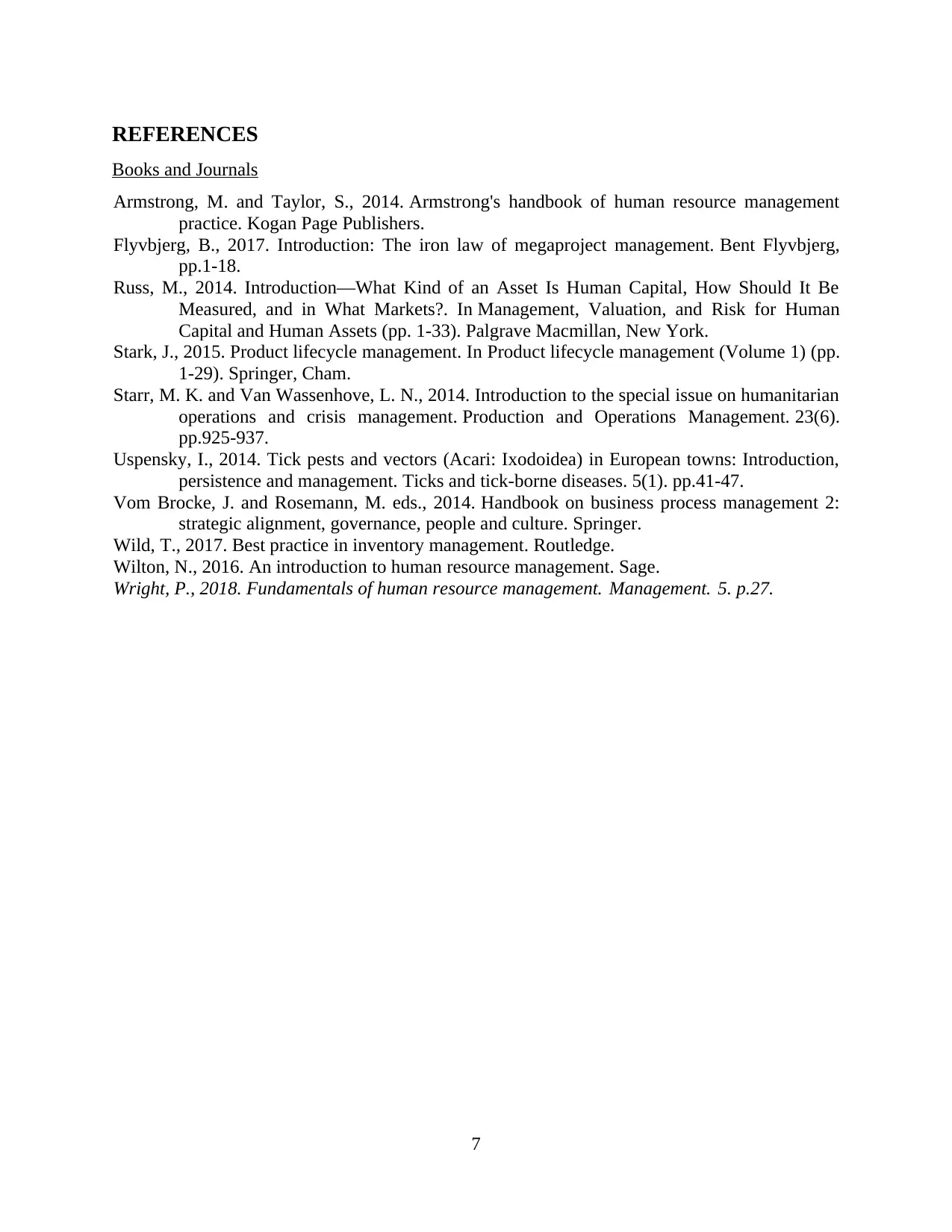
REFERENCES
Books and Journals
Armstrong, M. and Taylor, S., 2014. Armstrong's handbook of human resource management
practice. Kogan Page Publishers.
Flyvbjerg, B., 2017. Introduction: The iron law of megaproject management. Bent Flyvbjerg,
pp.1-18.
Russ, M., 2014. Introduction—What Kind of an Asset Is Human Capital, How Should It Be
Measured, and in What Markets?. In Management, Valuation, and Risk for Human
Capital and Human Assets (pp. 1-33). Palgrave Macmillan, New York.
Stark, J., 2015. Product lifecycle management. In Product lifecycle management (Volume 1) (pp.
1-29). Springer, Cham.
Starr, M. K. and Van Wassenhove, L. N., 2014. Introduction to the special issue on humanitarian
operations and crisis management. Production and Operations Management. 23(6).
pp.925-937.
Uspensky, I., 2014. Tick pests and vectors (Acari: Ixodoidea) in European towns: Introduction,
persistence and management. Ticks and tick-borne diseases. 5(1). pp.41-47.
Vom Brocke, J. and Rosemann, M. eds., 2014. Handbook on business process management 2:
strategic alignment, governance, people and culture. Springer.
Wild, T., 2017. Best practice in inventory management. Routledge.
Wilton, N., 2016. An introduction to human resource management. Sage.
Wright, P., 2018. Fundamentals of human resource management. Management. 5. p.27.
7
Books and Journals
Armstrong, M. and Taylor, S., 2014. Armstrong's handbook of human resource management
practice. Kogan Page Publishers.
Flyvbjerg, B., 2017. Introduction: The iron law of megaproject management. Bent Flyvbjerg,
pp.1-18.
Russ, M., 2014. Introduction—What Kind of an Asset Is Human Capital, How Should It Be
Measured, and in What Markets?. In Management, Valuation, and Risk for Human
Capital and Human Assets (pp. 1-33). Palgrave Macmillan, New York.
Stark, J., 2015. Product lifecycle management. In Product lifecycle management (Volume 1) (pp.
1-29). Springer, Cham.
Starr, M. K. and Van Wassenhove, L. N., 2014. Introduction to the special issue on humanitarian
operations and crisis management. Production and Operations Management. 23(6).
pp.925-937.
Uspensky, I., 2014. Tick pests and vectors (Acari: Ixodoidea) in European towns: Introduction,
persistence and management. Ticks and tick-borne diseases. 5(1). pp.41-47.
Vom Brocke, J. and Rosemann, M. eds., 2014. Handbook on business process management 2:
strategic alignment, governance, people and culture. Springer.
Wild, T., 2017. Best practice in inventory management. Routledge.
Wilton, N., 2016. An introduction to human resource management. Sage.
Wright, P., 2018. Fundamentals of human resource management. Management. 5. p.27.
7
⊘ This is a preview!⊘
Do you want full access?
Subscribe today to unlock all pages.

Trusted by 1+ million students worldwide
1 out of 9
Related Documents
Your All-in-One AI-Powered Toolkit for Academic Success.
+13062052269
info@desklib.com
Available 24*7 on WhatsApp / Email
![[object Object]](/_next/static/media/star-bottom.7253800d.svg)
Unlock your academic potential
Copyright © 2020–2025 A2Z Services. All Rights Reserved. Developed and managed by ZUCOL.





